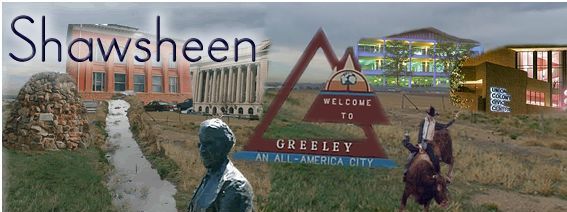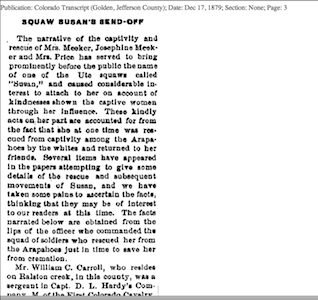
 |
||
 |
||
 |
||
 |
||
 |
||
 |
||
 |
||
 |
||
 |
||
 |
||
 |
||
 |
||
 |
||
|
Shawsheen Shawsheen was a Ute Indian Princess. Another tells that the soldiers saw her, they released her and one of the soldiers took her to his home. His wife cared for Shawsheen, sewed her calico dresses, gave her the name Susan and wanted to adopt her into the family. But she knew that Shawsheen wanted to go home to her people. They were waiting to get her home safely. The Arapaho were looking for her so it was dangerous for Shawsheen to leave. However, one day they returned home to find that Shawsheen had left taking clothes, some meat and a knife. Later some white men found her and were able to get her home to her people. One family story says that she escaped on her own. They do not tell of the rescue by soldiers. A Strategic Squaw How Susan, the Ute Woman affected the Meekers' Release By Pleading for Them in a Council of Warriors. The Chicago Tribune had other articles praising Shawsheen. One lady, Jane Gray Swisshelm asked Congress to let the Utes stay in Colorado and to grant Shawsheen and her family land in Colorado. Her requests were not granted. The cottonwood tree where Shawsheen was found was named “Susan’s Tree.” It was still standing in Island Grove
Park until the early 1900’s when it died. Shawsheen spent the rest of her life in Utah. |
|
 |
 |
| Here is a photo that is thought to be Shawsheen. The front says it is Chipeta, but a correction is made on the back that the woman is Susan (Shawsheen). Click on the thumbnail to see a larger photo. (Photo from Denver Public Library. See Credits.) | Shawsheen with her husband. Photo taken in 1870. (Photo from National Anthropological Archives, Smithsonian Museum Support Center. See Credit.) |
 |
 |
| Here is a display at the Greeley History Museum telling a bit about Shawsheen. | Here is a printable PDF of an article from 1879 telling about Shawsheen's rescue. ©Colorado Historic Newspapers |
| Here is a link to the article printed in 1879 about Shawsheen's rescue. | |
| PDF of text only about Shawsheen | |